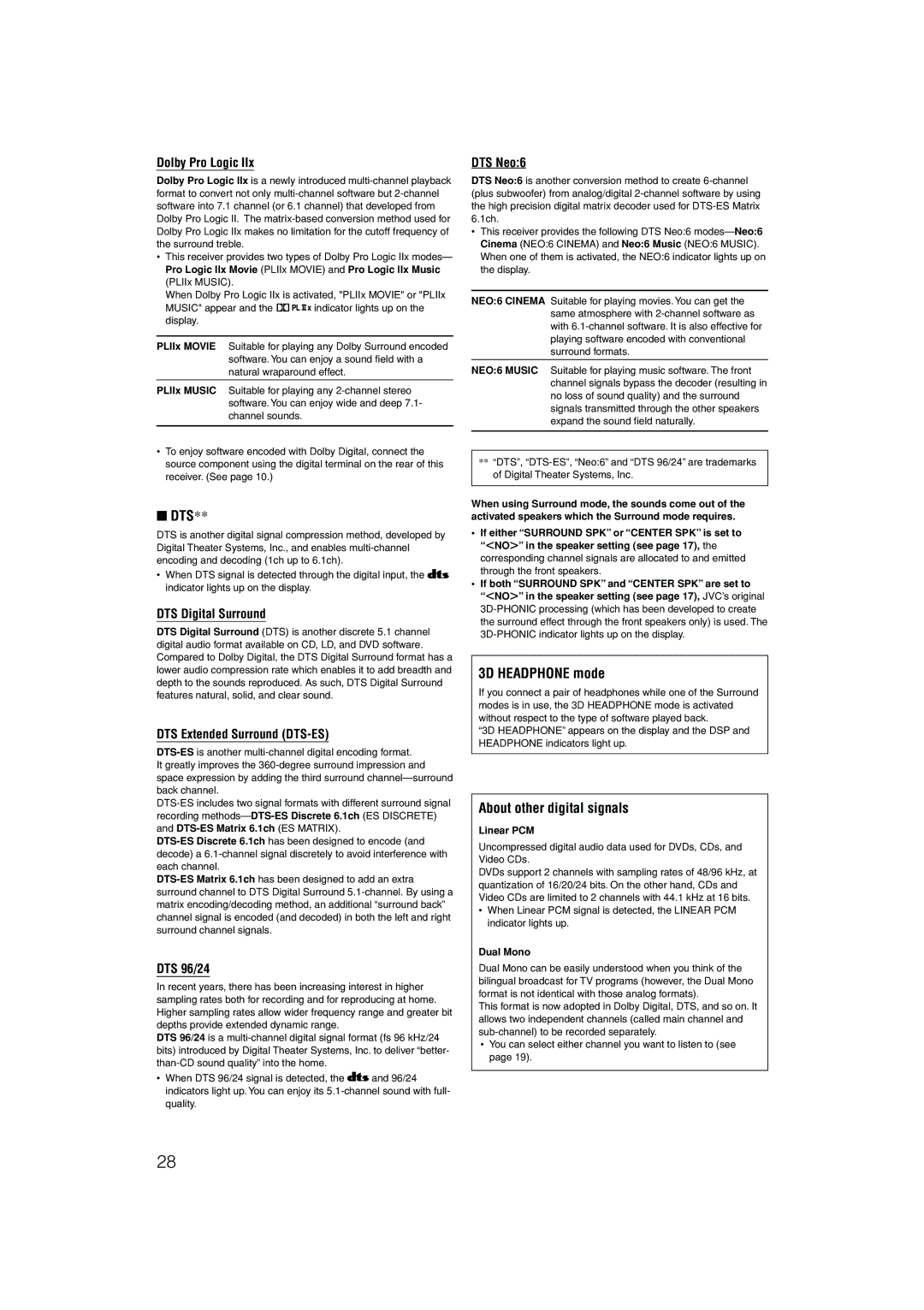Dolby Pro Logic IIx
Dolby Pro Logic IIx is a newly introduced multi-channel playback format to convert not only multi-channel software but 2-channel software into 7.1 channel (or 6.1 channel) that developed from Dolby Pro Logic II. The matrix-based conversion method used for Dolby Pro Logic IIx makes no limitation for the cutoff frequency of the surround treble.
•This receiver provides two types of Dolby Pro Logic IIx modes— Pro Logic IIx Movie (PLIIx MOVIE) and Pro Logic IIx Music (PLIIx MUSIC).
When Dolby Pro Logic IIx is activated, "PLIIx MOVIE" or "PLIIx
MUSIC" appear and the 

 indicator lights up on the display.
indicator lights up on the display.
PLIIx MOVIE Suitable for playing any Dolby Surround encoded software. You can enjoy a sound field with a natural wraparound effect.
PLIIx MUSIC Suitable for playing any 2-channel stereo software. You can enjoy wide and deep 7.1- channel sounds.
•To enjoy software encoded with Dolby Digital, connect the source component using the digital terminal on the rear of this receiver. (See page 10.)
■DTS**
DTS is another digital signal compression method, developed by Digital Theater Systems, Inc., and enables multi-channel encoding and decoding (1ch up to 6.1ch).
•When DTS signal is detected through the digital input, the  indicator lights up on the display.
indicator lights up on the display.
DTS Digital Surround
DTS Digital Surround (DTS) is another discrete 5.1 channel digital audio format available on CD, LD, and DVD software. Compared to Dolby Digital, the DTS Digital Surround format has a lower audio compression rate which enables it to add breadth and depth to the sounds reproduced. As such, DTS Digital Surround features natural, solid, and clear sound.
DTS Extended Surround (DTS-ES)
DTS-ESis another multi-channel digital encoding format.
It greatly improves the 360-degree surround impression and space expression by adding the third surround channel—surround back channel.
DTS-ES includes two signal formats with different surround signal recording methods—DTS-ES Discrete 6.1ch (ES DISCRETE) and DTS-ES Matrix 6.1ch (ES MATRIX).
DTS-ES Discrete 6.1ch has been designed to encode (and decode) a 6.1-channel signal discretely to avoid interference with each channel.
DTS-ES Matrix 6.1ch has been designed to add an extra surround channel to DTS Digital Surround 5.1-channel. By using a matrix encoding/decoding method, an additional “surround back” channel signal is encoded (and decoded) in both the left and right surround channel signals.
DTS 96/24
In recent years, there has been increasing interest in higher sampling rates both for recording and for reproducing at home. Higher sampling rates allow wider frequency range and greater bit depths provide extended dynamic range.
DTS 96/24 is a multi-channel digital signal format (fs 96 kHz/24 bits) introduced by Digital Theater Systems, Inc. to deliver “better- than-CD sound quality” into the home.
•When DTS 96/24 signal is detected, the  and 96/24 indicators light up. You can enjoy its 5.1-channel sound with full- quality.
and 96/24 indicators light up. You can enjoy its 5.1-channel sound with full- quality.
DTS Neo:6
DTS Neo:6 is another conversion method to create 6-channel (plus subwoofer) from analog/digital 2-channel software by using the high precision digital matrix decoder used for DTS-ES Matrix 6.1ch.
•This receiver provides the following DTS Neo:6 modes—Neo:6 Cinema (NEO:6 CINEMA) and Neo:6 Music (NEO:6 MUSIC). When one of them is activated, the NEO:6 indicator lights up on the display.
NEO:6 CINEMA Suitable for playing movies. You can get the same atmosphere with 2-channel software as with 6.1-channel software. It is also effective for playing software encoded with conventional surround formats.
NEO:6 MUSIC Suitable for playing music software. The front channel signals bypass the decoder (resulting in no loss of sound quality) and the surround signals transmitted through the other speakers expand the sound field naturally.
**“DTS”, “DTS-ES”, “Neo:6” and “DTS 96/24” are trademarks of Digital Theater Systems, Inc.
When using Surround mode, the sounds come out of the activated speakers which the Surround mode requires.
•If either “SURROUND SPK” or “CENTER SPK” is set to “<NO>” in the speaker setting (see page 17), the corresponding channel signals are allocated to and emitted through the front speakers.
•If both “SURROUND SPK” and “CENTER SPK” are set to
“<NO>” in the speaker setting (see page 17), JVC’s original 3D-PHONIC processing (which has been developed to create the surround effect through the front speakers only) is used. The 3D-PHONIC indicator lights up on the display.
3D HEADPHONE mode
If you connect a pair of headphones while one of the Surround modes is in use, the 3D HEADPHONE mode is activated without respect to the type of software played back.
“3D HEADPHONE” appears on the display and the DSP and HEADPHONE indicators light up.
About other digital signals
Linear PCM
Uncompressed digital audio data used for DVDs, CDs, and Video CDs.
DVDs support 2 channels with sampling rates of 48/96 kHz, at quantization of 16/20/24 bits. On the other hand, CDs and Video CDs are limited to 2 channels with 44.1 kHz at 16 bits.
•When Linear PCM signal is detected, the LINEAR PCM indicator lights up.
Dual Mono
Dual Mono can be easily understood when you think of the bilingual broadcast for TV programs (however, the Dual Mono format is not identical with those analog formats).
This format is now adopted in Dolby Digital, DTS, and so on. It allows two independent channels (called main channel and sub-channel) to be recorded separately.
•You can select either channel you want to listen to (see page 19).

